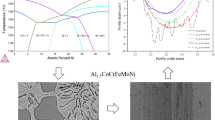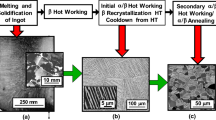Abstract
Structural transformations and tribological properties of a Ti49.4Ni50.6 alloy have been investigated at the liquid-nitrogen temperature. It has been shown that the alloy under study possesses the resistance to abrasive and adhesive wear smaller by a factor of 1.4–1.7 and the friction coefficient that is (to 1.7 times) higher, as compared to the austenitic steel 12Kh18N9. The only moderate tribological properties of the titanium nickelide are caused by an enhanced brittleness of this material under the conditions of friction-initiated severe plastic deformation. The enhanced low-temperature brittleness of the martensitic structure is seemingly explained by a low symmetry of the crystal lattice of the B19’ martensite, an atomically ordered state of this phase, and the formation of a brittle amorphous phase in the layer several microns thick near the friction surface of the alloy. The appearance of a continuous amorphous layer at the friction surface of the titanium nickelide is favored by the presence of the martensitic structure in the alloy, its stability under the friction conditions with respect to the reverse B19′ → B2 transformation, and a high intensity of the deformation processes occurring in the zone of friction contact. Below the amorphous layer, a mixed amorphous-crystal-line structure is located. The nanocrystallites are textured and range in size from a few to tens of nanometers. The formation of crystallites of the B2 phase in the amorphized layer appears to occur at the stage of warming of the alloy samples to room temperature. A similar amorphous-nanocrystalline structure arises near the abrasive-wear surface of the Ti49.4Ni50.6 alloy. It has been shown that the presence of a submicrocrystalline structure in the initial Ti49.4Ni50.6 alloy exerts no significant effect on the tribological properties and the character of structural transformations induced in the alloy by the frictional action.
Similar content being viewed by others
References
D. Y. Li, “A New Type of Wear-Resistant Material: Pseudo-Elastic TiNi Alloy,” Wear 221, 116–123 (1998).
D. Y. Li and Liu Rong, “The Mechanism Responsible for High Wear Resistance of Pseudo-Elastic TiNi Alloy-A Novel Tribo-Material,” Wear 225–229, 777–783 (1999).
Liu Rong and D. Y. Li, “Experimental Studies of Tribological Properties of Pseudoelastic TiNi Alloy with Comparison to Stainless Steel 304,” Metall. Mater. Trans. A 31, 2773–2783 (2000).
C. Zhang and Z. N. Farhat, “Sliding Wear of Superelastic TiNi Alloy,” Wear 267, 394–400 (2009).
L. G. Korshunov, V. G. Pushin, N. L. Chernenko, and V. V. Makarov, “Structural Transformations, Strengthening, and Wear Resistance of Titanium Nickelide upon Abrasive and Adhesive Wear,” Phys. Met. Metallogr. 110, 91–101 (2010).
L. G. Korshunov, V. G. Pushin, and N. L. Chernenko, “Effect of Frictional Heating on the Surface Layer Structure and Tribological Properties of Titanium Nickelide,” Phys. Met. Metallogr. 112, 290–300 (2011).
V. G. Pushin, V. V. Kondrat’ev, and V. N. Khachin, Pretransition Effects and Martensite Transformarions (Ural. Otd. Ross. Akad. Nauk, Ekaterinburg, 1998) [in Russian].
K. Otsuka and X. Ren, “Physical Metallurgy of TiNi-Based Shape Memory Alloys,” Prog. Mater. Sci. 50, 511–678 (2005).
V. G. Pushin, S. D. Prokoshkin, R. Z. Valiev, et al., Titanium Nickelide Shape Memory Alloys. Part 1. Structure, Phase Transformations and Properties (Ural. Otd. Ross. Akad. Nauk, Ekaterinburg, 2006) [in Russian].
J. C. Ewert, I. Bohm, R. Peter, and F. Haider, “The Role of the Martensite Transformation for the Mechanical Amorphization of NiTi,” Acta Mater. 45(5), 2197–2206 (1997).
H. Nakayama, K. Tsuchiya, and M. Umemoto, “Crystal Refinement and Amorphisation by Cold Rolling in TiNi Shape Memory Alloys,” Scr. Mater. 44, 1781–1785 (2001).
V. G. Pushin, V. V. Stolyarov, R. Z. Valiev, N. I. Kourov, N. N. Kuranova, E. A. Prokofiev, and L. I. Yurchenko, “Features of Structure and Phase Transformations in Shape Memory TiNi-Based Alloys after Severe Plastic Deformation,” Ann. Chim. Sci. Mater. 27(3), 77–88 (2002).
V. G. Pushin, V. V. Stolyarov, R. Z. Valiev, N. I. Kourov, N. N. Kuranova, E. A. Prokof’ev, and L. I. Yurchenko, “Development of Methods of Severe Plastic Deformation for the Production of High-Strength Alloys Based on Titanium Nickelide with a Shape Memory Effect,” Phys. Met. Metallogr. 94(Suppl. 1), S54–S68 (2002).
V. G. Pushin, A. I. Lotkov, Yu. R. Kolobov, R. Z. Valiev, E. F. Dudarev, N. N. Kuranova, A. P. Dyupin, D. V. Gunderov, and G. P. Bakach, “On the Nature of Anomalously High Plasticity of High-Strength Titanium Nickelide Alloys with Shape-Memory Effects: I. Initial Structure and Mechanical Properties,” Phys. Met. Metallogr. 106, 520–530 (2008)].
E. F. Dudarev, R. Z. Valiev, Yu. R. Kolobov, A. I. Lotkov, V. G. Pushin, G. P. Bakach, D. V. Gunderov, A. P. Dyupin, and N. N. Kuranova, “On the Nature of Anomalously High Plasticity of High-Strength Titanium Nickelide Alloys with Shape Memory Effects: II.Mechanisms of Plastic Deformation upon Isothermal Loading,” Phys. Met. Metallogr. 107, 298–311 (2009).
D. V. Gunderov, N. N. Kuranova, A. V. Luk’yanov, A. N. Uksusnikov, E. A. Prokof’ev, L. I. Yurchenko, R. Z. Valiev, and V. G. Pushin, “Application of Severe Plastic Deformation by Torsion to Form Amorphous and Nanocrystalline States in Large-Size TiNi Alloy Samples,” Phys. Met. Metallogr. 108, 130–138 (2009).
N. N. Kuranova, D. V. Gunderov, A. N. Uksusnikov, A. V. Luk’yanov, L. I. Yurchenko, E. A. Prokof’ev, V. G. Pushin, and R. Z. Valiev, “Effect of Heat Treatment on the Structural and Phase Transformations and Mechanical Properties of TiNi Alloy Subjected to Severe Plastic Deformation by Torsion,” Phys. Met. Metallogr. 108, 556–568 (2009).
J. Koike, D. M. Parkint, and M. Nastasi, “The Role of Shear Instability in Amorphization of Cold-Rolled NiTi,” Philos. Mag. Lett. 62(4), 257–264 (1990).
S. Miyazaki, T. Kawai, and K. Otsuka, “On the Origin of Intergranular Fracture in β Phase Shape Memory Alloys,” Scr. Metall. 16, 431–436 (1982).
L. G. Korshunov, “Structure Transformations during Friction and Wear Resistance of Austenitic Steel,” Fiz. Met. Metalloved., 74, 150–162 (1992).
L. E. Popov and E. V. Kozlov, Mechanical Properties of Ordered Solid Solutions (Metallurgiya, Moscow, 1970) [in Russian].
Author information
Authors and Affiliations
Additional information
Original Russian Text © L.G. Korshunov, V.G. Pushin, N.L. Chernenko, V.V. Makarov, 2012, published in Fizika Metallov i Metallovedenie, 2012, Vol. 113, No. 1, pp. 87–97.
Rights and permissions
About this article
Cite this article
Korshunov, L.G., Pushin, V.G., Chernenko, N.L. et al. Structural transformations and wear resistance of titanium nickelide under conditions of sliding friction at a cryogenic (−196°C) temperature. Phys. Metals Metallogr. 113, 82–92 (2012). https://doi.org/10.1134/S0031918X1201005X
Received:
Published:
Issue Date:
DOI: https://doi.org/10.1134/S0031918X1201005X




